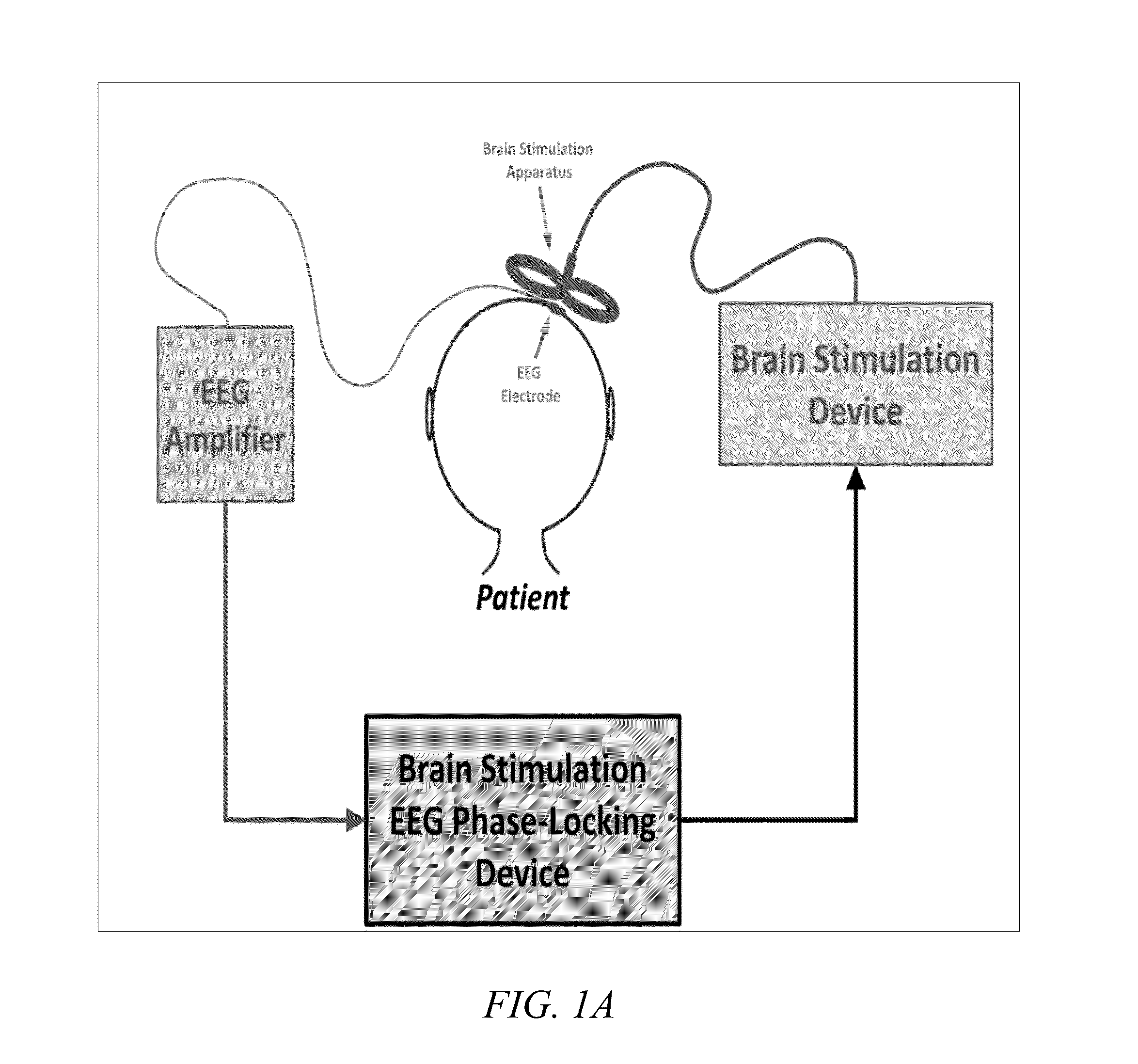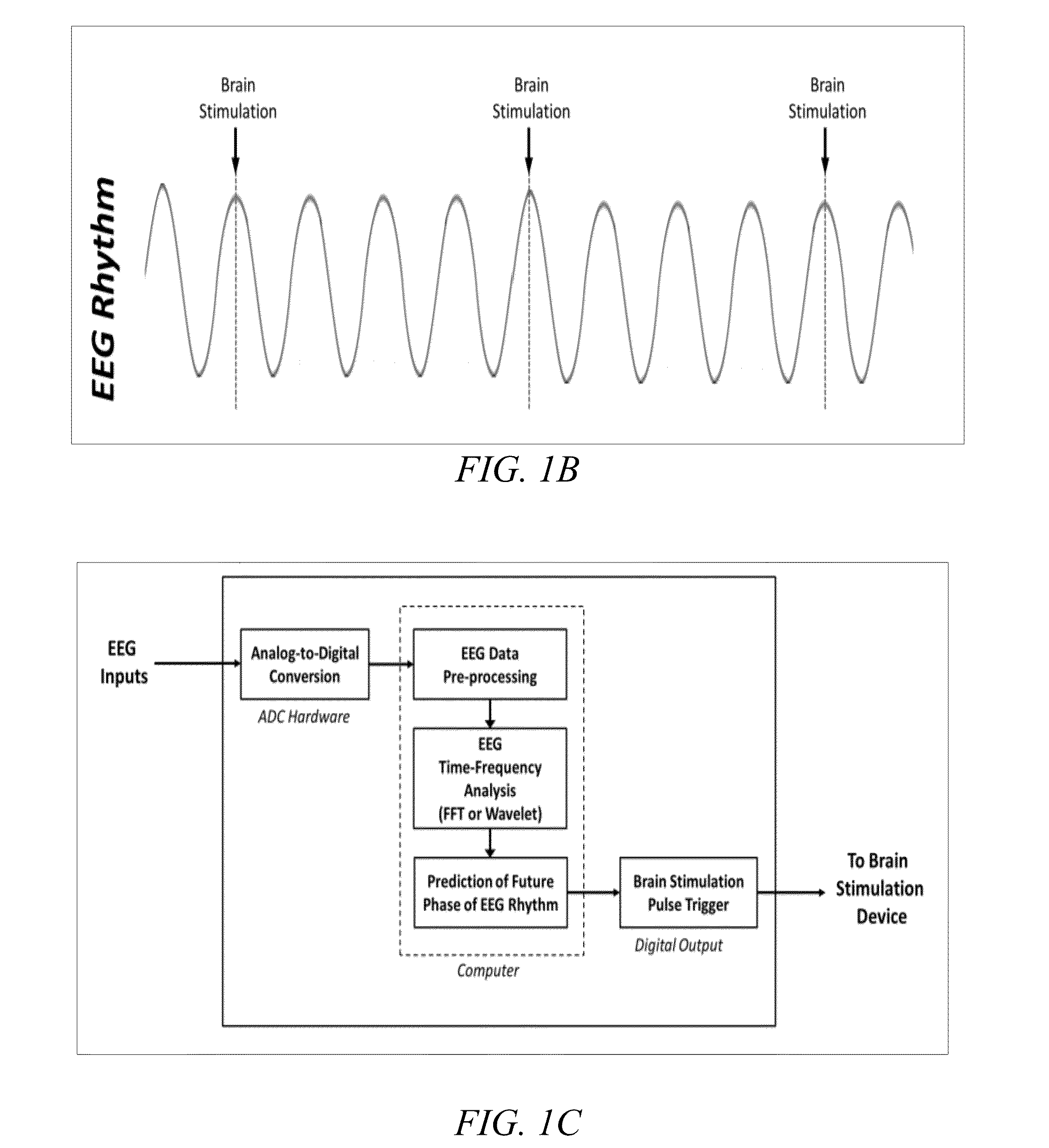Device and method of phase-locking brain stimulation to electroencephalographic rhythms
- Summary
- Abstract
- Description
- Claims
- Application Information
AI Technical Summary
Benefits of technology
Problems solved by technology
Method used
Image
Examples
example 1
[0060]For Example 1, pilot data (N=4) was collected from peak burst, trough burst, and conventional iTBS sessions. MEP and TEP data for pre-rTMS and one post-rTMS time point directly following rTMS administration (equivalent to the pre-rTMS and 10-minute post-rTMS measures of MEPs and TEPs) was collected, and plots of time-domain averages of EEG activity within a short time window leading up to a 50 Hz burst of TMS pulses are illustrated in FIG. 4, plotted separately for peak burst and trough burst conditions. Example 1 shows the intended phase differences and temporal alignment for these two rTMS stimulation protocols. The 50-Hz burst of three pulses onset at an average phase of 16.8° for peak burst and 159.4° for trough burst. The data from Example 1 demonstrates the feasibility and effectiveness of the device and method disclosed herein for time-locking to a desired alpha phase. Percent modulation of MEPs for peak burst, trough burst, and conventional iTBS is presented in FIG. 5,...
example 2
[0061]Example 2 addresses alpha phase and excitatory rTMS in order to determine the relationship between alpha phase and TMS-induced excitation in the human cortex. Alpha oscillations reflect cycles of inhibition in cortex, and as such, the instantaneous phase of alpha reflects the present state of excitability in cortex as it relates to the naturally occurring synchronous networks reflected in alpha. As a subpopulation of neurons within cortex is expected to be synchronously activated (or deactivated) according to alpha phase, inducing a state of neuroplasticity with TMS at a particular phase in order to provide a method of enhancing LTP within a target population of cells and / or modulating inter-regional communication. Alpha phase-related effects of TMS-induced excitability are examined by time-locking high-frequency bursts of TMS to peaks or troughs of alpha phase and comparing pre- and post-measures of cortical excitability from MEPs, TEPs, and ERPs. Example 2 compares the magni...
example 3
[0070]Example 3 addressed alpha phase and inhibitory rTMS (1 Hz) and determined the relationship between alpha phase and TMS-induced inhibition in the human cortex. Inhibitory effects on cortical excitability induced in the human brain by 1-Hz rTMS result from NMDA-dependent mechanisms of LTD. Like LTP, the induction of LTD is also activity dependent, requiring suprathreshold levels of low-frequency stimulation. Thus, the inhibitory effects of 1-Hz rTMS would also be expected to interact with the level of synchronized cortical excitability, just as high-frequency would. Example 3 examined this possibility by administering a 1-Hz inhibitory rTMS protocol with TMS pulses time-locked to specific phases of the alpha rhythm (peak or trough). As in Example 2, Example 3 compares the efficacy of alpha phase-locked 1-Hz rTMS to a standard 1-Hz rTMS protocol and a sham stimulation session.
[0071]Procedure.
[0072]The procedure of Example 3 was identical to that of Example 2 above 1 with the exce...
PUM
 Login to View More
Login to View More Abstract
Description
Claims
Application Information
 Login to View More
Login to View More - R&D
- Intellectual Property
- Life Sciences
- Materials
- Tech Scout
- Unparalleled Data Quality
- Higher Quality Content
- 60% Fewer Hallucinations
Browse by: Latest US Patents, China's latest patents, Technical Efficacy Thesaurus, Application Domain, Technology Topic, Popular Technical Reports.
© 2025 PatSnap. All rights reserved.Legal|Privacy policy|Modern Slavery Act Transparency Statement|Sitemap|About US| Contact US: help@patsnap.com



